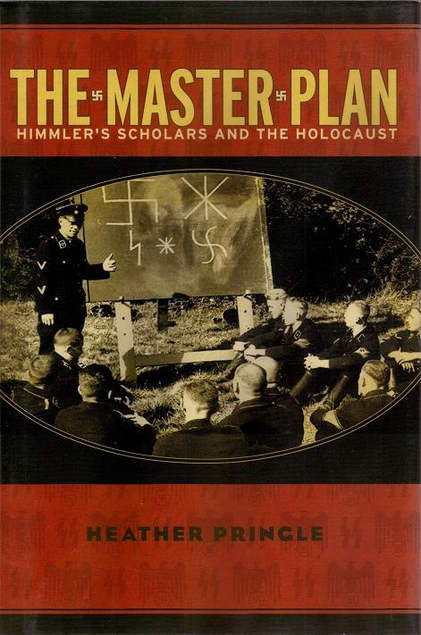The Long View: The Master Plan

The Ahnererbe was a peculiar institution in the Third Reich. It had an independent source of revenue in the form of a bicycle reflector patent, which meant that while some of its activities were favored and supported, others weren’t, but it could continue regardless. Its research was a weird mix of actual science and crank obsessions. Real history tends to be better than any comic book.
The Master Plan: Himmler's Scholars and the Holocaust
By Heather Pringle
Disney Books (Little Brown), 2006
463 pages, $18.96
ISBN-10: 0786868864
https://amzn.to/31Tt3th
The Third Reich was certainly influenced by “rejected knowledge” to some degree: many of its principal figures made reference on occasion to occult ideas or to cranky pseudoscientific theories, and at least some of its symbols and ceremonial seem to have been transmitted to it through the Occult Revival of the latter 19th century. One of the most interesting questions in the history of the 20th-century, however, is whether rejected knowledge was central or even constitutive of German National Socialism and of the Third Reich, or whether such ideas were “in the air” at the intersection of politics and popular culture but had no important effect on the regime.
What makes this study by Heather Pringle (a science-writer with an interest in archeology) so valuable is that she does not try to answer the whole question. We don’t get much intellectual history in the text, though the bibliography cites all the major studies. Rather, she focuses on the eccentric research interests of SS-leader Heinrich Himmler, particularly as those were manifest in the activities of an SS bureau known as the “Ahnenerbe.” (The term can be translated in various ways: I would go with “Ancestral Legacy.”) The Ahnenerbe has long played a role in popular history and fiction as the “SS Occult Bureau.” In this book, it is reduced to its proper proportions as an “advocacy-research” service that, before the war, funded some odd enterprises but was otherwise a small organization that worried about its budget and had to hunt for office space. During the war, though, the Ahnenerbe expertise in “racial science” was called upon to facilitate aspects of the Holocaust, while its more conventional medical expertise played a role in criminal human experiments. Several of its members were executed for war crimes, including its managing director, Wolfram Sievers (but not its president, Walther Wüst: like many of the people in this book, he lived to a remarkable old age). Not all of the story is new: the Tibetan expedition of Ernst Schäfer in 1938-39 has been covered in detail before. Even so, this book provides useful supplementary information. And the title is not wholly misleading: Himmler’s use of the Ahnenerbe really does provide important context for describing what the Nazis were trying to do.
Bicycles funded the search for Atlantis. The SS contrived to get control of a patent for pedal-mounted safety reflectors, and then made the use of those reflectors mandatory. The money went to support the Ahnenerbe after its organization in 1935. Himmler felt that some independent source of funding was necessary, because Hitler was not usually keen on Himmler’s investigations into folklore and the borders between history and myth.
Hitler was a free-thinker on these matters. Statements of his can be used to show that he believed in various forms of psychic power, in pre-Ice Age civilizations, and even in Hans Hörbiger’s “World Ice Theory.” (That was a catastrophist model of world history proposing that the Earth had in the past captured a series of moons whose later disintegration had caused a corresponding series of deluges and world ages.) He was also in tune with Himmler on the centrality of race to history, both with regard to the splendid Aryan race in the past and its even more splendid revival in the future. They agreed on the characterization of Jewry as an essentially biological phenomenon that had to be exterminated. Hitler parted company from Himmler, however, regarding the latter’s high evaluation of the pre-historical Nordic past. Himmler was avid to view archeological digs of ancient Germanic settlements and to reconstruct the religion and ethos of the people who had dwelt there. For when empirical investigation failed, he had a literal shaman in his employ, the famous Karl-Marie Willigut, who would channel the ancient dead for Himmler’s edification. (Willigut in a trance could put on a good show, apparently: he told the skeptical Ernst Schäfer some things about Tibet that Schäfer thought only he knew.) Hitler, in contrast, was rather embarrassed by these digs, at least when they dealt with settlements dating from the Roman era; even the most ingenious long-house did not amount to much compared to the Coliseum. Further more, Himmler not only hoped to replace Christianity; he promoted the use by the SS of a calendar of neopagan rituals to replace the Christian ones. Hitler liked this not at all: he may have been a dictator and an apostate who had long-term plans for Christianity, too, but he was also a practical politician who took care not to gratuitously provoke the Catholic and Protestant Churches.
Himmler had been hiring researchers individually since the Nazi Party came to power in 1933. The most important of these, perhaps, was the Grail-hunter Otto Rahn, later an Ahnenerbe member (he is mentioned only in passing in this book). The interest that some senior members of the Nazi Party took in esoteric studies became increasingly well-known. A coffee-magnate built, or planned to build, a “Haus Atlantis” on Böttcherstrasse in Bremen. The structure was to be largely in honor of the first president of the Ahnenerbe, Herman Wirth, a Dutch philologist who had detailed and publicly expressed ideas about where the remnants of Atlantis, the homeland of the Aryan race, might be found in the Atlantic. He also claimed to have discovered the world’s first writing system in the petroglyphs of southeastern Sweden, a view not widely shared then or since. A crisis occurred at the Nuremberg Rally of 1936. Hitler took the trouble to denounce “Böttcherstrasse Culture” as an example of an excessively mystical interpretation of National Socialism. In this, I might point out, he was reiterating the dismissal in Mein Kampf of “völkisch” nationalism. One way to put it, I suppose, was that Hitler was condemning the New Age wing of the Party.
This was an awkward turn of events for Himmler (as I suppose it must also have been for Alfred Rosenberg, the Party ideologist who also had some good words for Atlantis in The Myth of the 20th Century but who did not have any bicycle money to console him). The next year, Himmler replaced Wirth with Walther Wüst, a respectable orientalist who was also keenly interested in Aryans, but in his case they were the less imaginary ones to be found in Sanskrit and Old Persian texts. (The term “Aryan” comes from Sanskrit philology.) Some of the more exotic-sounding projects were closed down. By no means were they all crank schemes, however. One of the projects was a sound-recording tour by a young Finn named Yrjö von Grönhagen of the Karelia region of Finland. His goal was to record the spells and tales of the shamans and witches of the region, which he did in what sounds like an example of ordinary anthropology. The problem was that there was already an extensive literature about the relationship of Finnish folk culture and language to that of ancient Germanic northern Europe, and Wüst quickly satisfied himself that Grönhagen knew nothing about it. He was sent back to the classroom.
The Ahnenerbe thereafter focused on studies that were more verifiable, and even practical, at least from the SS point of view. The bureau backed reputable archeological digs of ancient villages (Hitler could not be everywhere) and funded the excavation of their share of cavemen. An irony here: the scientific consensus at the time had it that Cro-Magnon humans had evolved from the Neanderthalers, but Himmler believed otherwise. Today most anthropologists would say that Himmler was right, but as a rule, Himmler’s ideas were wrong or incoherent. The Party line could raise issues of professional ethics for researchers whose results did not seem to lead them to politically congenial conclusions. To judge by this book, the Ahnenerbe often did serious research that provided useful data, provided you ignored the conclusions.
The Ahnenerbe sometimes mixed science with useful espionage. That was the case with the classics scholar, Franz Altman, who combined library and archeological research in Italy, Dalmatia, and the Middle East with some political and logistical snooping. In Iraq and Syria, he tactfully sounded out local Arab tribal leaders about their attitude toward a revolt against the French and British (they were keen) and laid some of the groundwork for the unsuccessful pro-Axis uprising that occurred during the war. As with many of the scholars in this study, his work for the Ahnenerbe did his career no permanent harm; after the war, be became West Germany’s most eminent classicist.
The crown jewel of all Ahnenerbe projects was the Schäfer expedition to Tibet. At least in Himmler’s mind, the expedition was to demonstrate that Tibetan civilization had been created by an ancient incursion of Aryan conquerors who had then become the upper class. The expedition did quite a lot of animal specimen collecting (Schäfer himself was a zoologist of the megafauna-shooting variety), but its primary purpose was the racial classification of humans. That was chiefly the task of a young racial-studies expert, Bruno Beger. This work involved the detailed study of skull shape and bone length with calipers and rulers, and the making of plaster face-casts. The author tells us that anthropology had largely abandoned this kind of study; it had already been discovered by that time that body shape was dependent on other factors in addition to genetics, and therefore was unhelpful for the taxonomy of human groups. Nonetheless, data of this sort were still taken seriously in Germany. Indeed, they would arguably be the foundation of the Nazi version of applied geopolitics.
The outbreak of war cancelled what would have been the Ahnenerbe’s largest expedition so far: a journey by the sweetly crackers Edmund Kiss to examine million-year-old Aryan ruins in Bolivia. The bureau then turned from theoretical research to aiding the war effort. This rarely had happy results. The most gruesome parts of the book deal with a war-time Ahnenerbe department, the Institute for Military Research. When you hear about Nazi scientists doing deranged-sounding experiments on living subjects, that is probably the group in question. However, there was more to the Ahnenerbe war record than experiments with poison gas and sterilization through irradiation.
As a group with a high level of historical and cultural expertise, the Ahnenerbe was soon prevailed upon to send its agents to remove interesting items from the museum collections of occupied countries. In Poland, they immediately encountered the agents of Hermann Göring, who also liked expensive things and felt entitled to steal them. The agents of Himmler and Göring reached a rough compromise: Göring got most of the fine art of the past few centuries, while the Ahnenerbe got most of the ancient and archeologically important material. The stuff that found its way into Göring's treasuries usually survived the war, but many valuable artifacts were destroyed when the SS partially demolished its academy at Wewelsburg Castle at the end of the war.
Hitler is quoted in this book as saying that his aims were really quite modest: all he wanted to do was resettle the German people on territory that they had occupied before. The disruptive factor was that the romantic popular history promoted by people like the Ahnenerbe said that the Germans, during their earlier incarnation as Goths, had once had a vast empire in most of what is now European Russia. These beliefs had some slight overlap with history in the Crimea, where there had in fact been Gothic cities that alternately attacked and traded with the eastern Roman world in late antiquity. When the Germans occupied the Crimea during their invasion of the Soviet Union, Ahnenerbe scientists went to the Crimea to find the ruins of the Gothic capital and prepare an itinerary for a visit by Himmler.
During this highpoint of Nazi power, Himmler actually took the first steps towards implementing the only real Master Plan the Nazis had: the creation of a German empire the size of a subcontinent. The German military was apparently not supposed to press on all the way through Siberia, but to create an impenetrable border along the Urals. Ahnenerbe officials fantasized about the huge estates they would soon be given in the East. First, though, a new yeomanry was to be settled in what had been the Russias, using persons certified by Ahnenerbe techniques as racially German. Himmler’s experts had the designs for the new villages all prepared, down to the traditional Germanic amphitheaters for public meetings.
Some luckless ethnic Germans from northern Russia were conscripted to begin this project and sent to the Crimea. There they were given small farms on sharecropper-terms: a quota of dairy products for the SS, in return for protection and some material support. The settlers were promised more land if their performance was satisfactory. The project did not come to anything. We may surmise that similar projects would not have come to much, even if Stalin or his successor had made peace with Hitler. There just weren’t that many Germans, inside or outside Germany, who aspired to become peasants. Any persons who were so inclined would probably not have prospered in new settlements that seem likely to have all the organic vitality of a Stalinist collective farm. A Nazi victory would have created a vacuum.
The book touches on several contexts in which Ahnenerbe racial science played a role in the war against the Jews. One of these involved the attempt by Nazi officials to deal with the fact that the ethnology of the Caucasus included mysteries that did not fit their philosophy. The term “Khazar” does not occur in this book, but the Nazis found groups of people, the Mountain Jews, rather like the semi-legendary Khazars: ethnically Turkic tribes, with a manner of life like that of Cossacks, but who identify their religion as Judaism. Except they weren’t necessarily Turkic, either. To complicate matters further, the peoples of the region were not divided into self-contained millets, as in the Middle East, but intermarried and shared their customs. The Nazis were quite prepared to slaughter the genuinely Jewish tribes, but they could not believe that some of the Taras Bulba types they were meeting were really Jewish. So, Ernst Schäfer and Bruno Beger were summoned again, this time to the Caucasus to separate the sheep from the goats. They were to use racial-science criteria to decide whether a people were Jewish or not. If the group met the measurement criteria, it would be eliminated, even if its members prayed toward Mecca five times a day.
As things turned out, the Nazi presence in the Caucasus was too brief for Schäfer and Beger's new expedition to be sent, but the author takes special care to put Beger's role in the later "Jewish Skeleton" project in the worst possible light, which is admittedly pretty bad. The project has been variously described, but the gist of it was that prisoners in concentration camps were to be selected as anatomically typical, killed, and taken to a laboratory in the west where they would be stripped of their flesh; the skeletons were then to become displays in a research museum. Beger later claimed that he had no idea that the people he was measuring at Dachau were to be used for any such purpose, or at least that he found out when it was too late. He suffered some legal troubles in later life when these matters came to light, but experienced embarrassment rather than punishment. The author describes her interview with him in an apartment full of Tibetan mementos: a preternaturally hale and wholly unrepentant 90 year old, like an ambiguous knight who had managed to take a swig from Otto Rahn’s life-prolonging Grail.
The Ahnenerbe was something of a comfort to Himmler in his final days. He had long believed that the legends of Thor’s Hammer and similar stories from the Vedas contained historical memories of wonder weapons used by vanished civilizations. He avidly received reports that they had been rediscovered. One such proposal in the closing weeks of the war led him to declare that the military situation was about to reverse. From the description in the book, the weapon sounds a bit like an electromagnetic-pulse device, but with some relationship to ground current that would have allowed it to disable all electrical equipment across wide regions. The Ahnenerbe duly sent the proposal out for review and eventually reported that the inventor did not know what he was talking about. Nonetheless, while that hope still lived, Himmler had reason to keep the war going. We should remember that Willigut, his own wizard, had prophesied that an invasion of Europe from the East in the 20th century would be stopped at Wewelsburg Castle. The Russians never got so far west, but the Vedic EMP device would have fit the prophecy nicely.
Even a review this long cannot mention all the Ahnenerbe activities the book discusses. Similarly, the book does not purport to be an encyclopedic account of everything the Ahnenerbe did, and it scarcely touches at all on the role of rejected knowledge in the Nazi regime as a whole. It does, however, cover quite enough to be essential reading for anyone interested in this subject.
Copyright © 2007 by John J. Reilly
Support the Long View re-posting project by downloading Brave browser. With Both Hands is a verified Brave publisher, you can leave me a tip too!



Comments ()